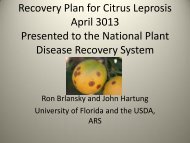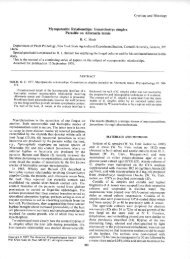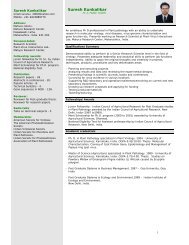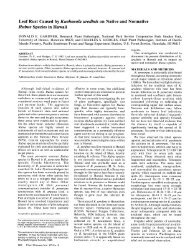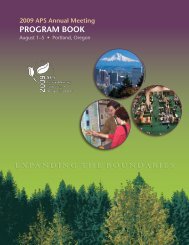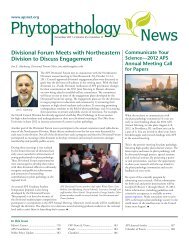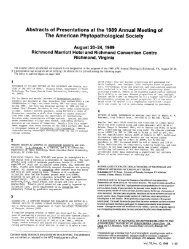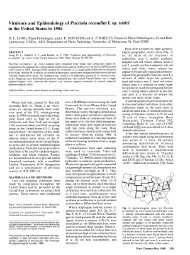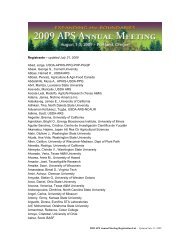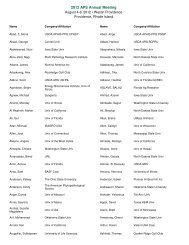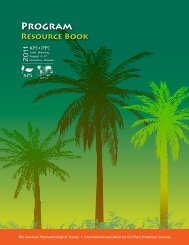See the program book (PDF) - American Phytopathological Society
See the program book (PDF) - American Phytopathological Society
See the program book (PDF) - American Phytopathological Society
You also want an ePaper? Increase the reach of your titles
YUMPU automatically turns print PDFs into web optimized ePapers that Google loves.
Second plenary Session<br />
Monday, July 28 • 9:40 a.m. – 12:00 p.m. • Auditorium<br />
9:40-10:00 a.m.<br />
Ray Martyn<br />
“Welcome and Introduction”<br />
Professor, Department of Botany and Plant Pathology, Purdue<br />
University, and APS President.<br />
10:00-10:30 a.m.<br />
Charles Arntzen<br />
Regent’s Professor and F.E. Nelson<br />
Presidential Chair, Arizona State University;<br />
U.S. National Academy of Sciences,<br />
1983; former president and CEO, Boyce<br />
Thompson Institute; U.S. President’s<br />
Council of Advisors on Science and<br />
Technology (2001-present); and past-president, <strong>American</strong><br />
<strong>Society</strong> of Plant Biologists (1985-86).<br />
“Biopharming and Plant-Derived Pharmaceuticals”<br />
Although plants have been used for millennia as sources<br />
of medicinal products, it is only in <strong>the</strong> last decade that <strong>the</strong><br />
tools of genetic engineering have been applied to plants to<br />
create a new biomanufacturing system for pharmaceutical<br />
products. Protein drugs, such as monoclonal antibodies,<br />
subunit vaccines, and human enzymes are examples of new<br />
products that can be produced in plants. The status of plant<br />
biotechnology used for pharmaceutical expression in plants,<br />
lead products in <strong>the</strong> pipeline, and relevant regulatory processes<br />
to ensure safety and efficacy of <strong>the</strong>se products will be reviewed.<br />
10:35-11:05 a.m.<br />
Roger Beachy<br />
President and Director, The Donald<br />
Danforth Plant Science Center, St. Louis;<br />
U.S. National Academy of Sciences, 1997;<br />
Wolf Prize in Agriculture, 2001; and<br />
editorial board, Proceedings of <strong>the</strong> National<br />
Academy of Sciences.<br />
“Plant Biotechnology and Agriculture: Is There a Role for<br />
Public Sector Scientists?”<br />
Plant virus infections can occur in most crop plants and in<br />
some cases are controlled by specific or non-specific host<br />
genes that confer resistance or tolerance. In cases where genes<br />
for host resistance are not identified, a variety of transgenic<br />
approaches have been demonstrated to be effective in<br />
conferring virus resistance. This lecture will explore <strong>the</strong> role of<br />
selected transgenic technologies in virus disease resistance and<br />
<strong>the</strong> potential to reduce virus diseases and enhance crop yields.<br />
11:10-11:40 a.m.<br />
Gilbert Omenn<br />
Director, Center for Computational<br />
Medicine and Biology and Professor of<br />
Internal Medicine, Genetics and Public<br />
Health, University of Michigan; former<br />
CEO, University of Michigan Health<br />
System, and Dean, University of Washington<br />
School of Public Health & Community Medicine; pastpresident,<br />
A.A.A.S. 2006; and Associate Director, Office of<br />
Science and Technology Policy (Carter administration).<br />
“The Interface of Science and Policy: The Crucial Roles of<br />
Food and Health in Economic Development”<br />
Improved health for <strong>the</strong> entire population, especially those<br />
in deep poverty and/or disenfranchised subpopulations, is<br />
an imperative in every country for individuals to learn, to<br />
contribute to economic growth, and to make decisions that<br />
help control population numbers. The eight U.N. Millennium<br />
Development Goals for 2015 are based on credible science and<br />
feasible technology, broad political agreement with financial<br />
commitments in 2001, and an overall integrated strategy,<br />
complemented by health and agricultural initiatives from <strong>the</strong><br />
Bill & Melinda Gates Foundation and o<strong>the</strong>rs. Never<strong>the</strong>less, at<br />
this midpoint to 2015, <strong>the</strong>re is a chasm between good science<br />
and lofty goals, on <strong>the</strong> one hand, and real progress, especially<br />
in sub-Saharan Africa, Latin America, <strong>the</strong> Middle East, and<br />
North Africa. The main challenges are poor governance,<br />
extreme poverty, growing inequalities even within prosperous<br />
countries, and policy neglect, compounded by inadequate<br />
global investment.<br />
virtual Flash-and-dash poster<br />
presentations<br />
Saturday – Wednesday • Entrance to Exhibit Hall C<br />
Launching into <strong>the</strong> next century of APS, a selected group<br />
of Flash-and-Dash presentations will go virtual as part of<br />
<strong>the</strong> Centennial celebration. Voice-overlaid PowerPoint<br />
presentations of ten Flash-and-Dash poster presentations<br />
were made in advance and are available during and after <strong>the</strong><br />
Centennial meeting. These presentations will run outside<br />
Exhibit Hall C during <strong>the</strong> meeting and are available on <strong>the</strong><br />
annual meeting website at http://meeting.apsnet.org.<br />
party through <strong>the</strong> decades – Closing Final<br />
night Celebration<br />
Tuesday, July 29 • 7:30 p.m. – 10:30 p.m. • Ballroom AB<br />
What Centennial celebration would be complete without<br />
a final night party? Immediately following <strong>the</strong> Awards and<br />
Honors Ceremony, enjoy a complete buffet and beverages and<br />
celebrate <strong>the</strong> APS Centennial with a commemorative toast and<br />
birthday cake. Dance through <strong>the</strong> decades with <strong>the</strong> popular<br />
Minneapolis-based group Belladiva, as <strong>the</strong>y take you through<br />
<strong>the</strong> boogey woogey days of <strong>the</strong> 30s and 40s to <strong>the</strong> rocking 90s.<br />
19



